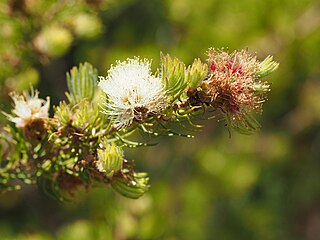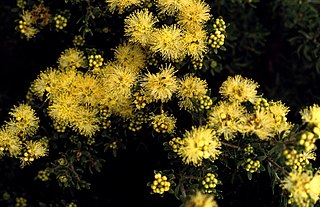
Melaleuca fulgens, commonly known as the scarlet honey myrtle, is a plant in the myrtle family Myrtaceae, and is endemic to Western Australia, South Australia and the Northern Territory. It is notable for its showy orange, red or purple flowers, unusual foliage and fruit, and is a popular garden plant. It is a member of Melaleuca, a large and diverse genus whose members range from large trees such as M. quinquenervia, to small shrubs.

Melaleuca alsophila, commonly known as the saltwater paperbark, is a plant in the myrtle family, Myrtaceae and is endemic to the north of Western Australia. It is a dense shrub or small tree with fibrous or papery bark and is common in areas seasonally inundated during the wet season.

Melaleuca urceolaris is a low, spreading shrub in the myrtle family Myrtaceae and is endemic to the south-west of Western Australia. Although it is rare in cultivation, it is an attractive garden plant due to its soft foliage and white flowers which fade to pink or red. It is similar to Melaleuca scabra with which it has often been confused.

Melaleuca undulata, commonly known as hidden honey-myrtle is a shrub in the myrtle family Myrtaceae and is endemic to the south of Western Australia. It is a spreading, moderately dense, perennial, woody shrub with creamy-white flowers in small clusters.

Melaleuca lecanantha is a plant in the myrtle family, Myrtaceae and is endemic to a small area of south-west Western Australia. It is a shrub with small, rather fleshy leaves and pink to lilac-coloured flowers in early spring. The plant was first described in 1867 but the name given to it was considered illegitimate and it was not until 1998 that it was first formally described.

Melaleuca leiopyxis is a shrub in the myrtle family, Myrtaceae and is endemic to an area near the west coast of Western Australia. It has bright yellow flowers and is very similar to Melaleuca depressa. The ranges of the two species overlap making it difficult to distinguish between them.
Melaleuca basicephala is a plant in the myrtle family, Myrtaceae and is endemic to the south-west of Western Australia. It is a rarely-seen shrub from the dense freshwater swamps of the wet far south-west corner of the state.

Melaleuca dichroma is a shrub in the myrtle family, Myrtaceae and is endemic to the south-west of Western Australia. It is unusual for its genus in that its flowers are yellow or creamy-white but age to a pinkish-red.

Melaleuca incana subsp. tenella is a plant in the myrtle family Myrtaceae which is endemic to the south coast of Western Australia. It was formerly known as Melaleuca tenella Benth. but was reduced to a subspecies in 1998. It is similar to M. incana subsp. incana except in the form of the plant, the size and shape of its leaves, its flowering time and distribution.

Melaleuca acutifolia is a plant in the myrtle family, Myrtaceae and is endemic to the south-west of Western Australia. It has small, pointed, oval leaves and in summer, heads of white flowers. The species was originally described as a variety of Melaleuca lateriflora but was raised to species status in 2010.

Melaleuca lateriflora, commonly known as gorada, is a plant in the myrtle family, Myrtaceae and is endemic to the south-west of Western Australia. It is usually an erect shrub with oval leaves and small clusters of white flowers mainly along the older branches.
Melaleuca linophylla is a plant in the myrtle family Myrtaceae and is native to the north-west of Western Australia. It is a bushy shrub with narrow leaves and spikes of cream-coloured flowers in spring. It is distinguished by its fruits which are much more urn-shaped than those of other melaleucas.
Melaleuca manglesii is a plant in the myrtle family Myrtaceae and is endemic to a small area in the south-west of Western Australia. It is a low, spreading shrub which produces large numbers of heads of purple flowers with yellow tips in spring.

Melaleuca megacephala is a plant in the myrtle family Myrtaceae and is native to the south-west of Western Australia. It is distinguished by its large, hemispherical heads of yellow and white flowers on the ends of the branches and the overlapping brown bracts under them.

Melaleuca micromera, commonly known as wattle honey-myrtle, is a plant in the myrtle family Myrtaceae and is endemic to a small area in the south-west of Western Australia. It is a rare species with unusual foliage and profuse small yellow flowerheads, making it a plant that is suitable for cultivation, if only to protect it from extinction.

Melaleuca microphylla is a plant in the myrtle family, Myrtaceae and is endemic to a small area in the south-west of Western Australia. It is a bushy shrub with small, crowded leaves and bears a close resemblance to the commonly cultivated Melaleuca ericifolia of the eastern states.

Melaleuca polycephala is a shrub in the myrtle family, Myrtaceae, and is endemic to the south-west of Western Australia. It is a sparsely foliaged, twiggy shrub with deep purple flowers in spring.

Melaleuca psammophila is a plant in the myrtle family, Myrtaceae, and is endemic to the south-west of Western Australia. It is a small shrub with narrow leaves, heads of purple, pink or mauve flowers and clusters of woody fruit. It is similar to M. bisulcata but differs from that species in characters such as the shape of its fruit, leaves and buds but like that species is an attractive, profusely flowering shrub suitable for cultivation as a garden plant.
Melaleuca sericea is a plant in the myrtle family, Myrtaceae, and is endemic to the north of Western Australia and the north-west of the Northern Territory. It is a paperbark similar to Melaleuca dealbata but its leaves are covered with silky hairs, the flowers are whitish by comparison and it does not grow as tall as that species.

Beaufortia incana, commonly known as grey-leaved beaufortia, is a plant in the myrtle family Myrtaceae, and is endemic to southwest of Western Australia. It is a shrub with crowded leaves that appear whitish due to their covering of fine, soft hairs on both surfaces. It has almost spherical heads of red flowers in spring.
















